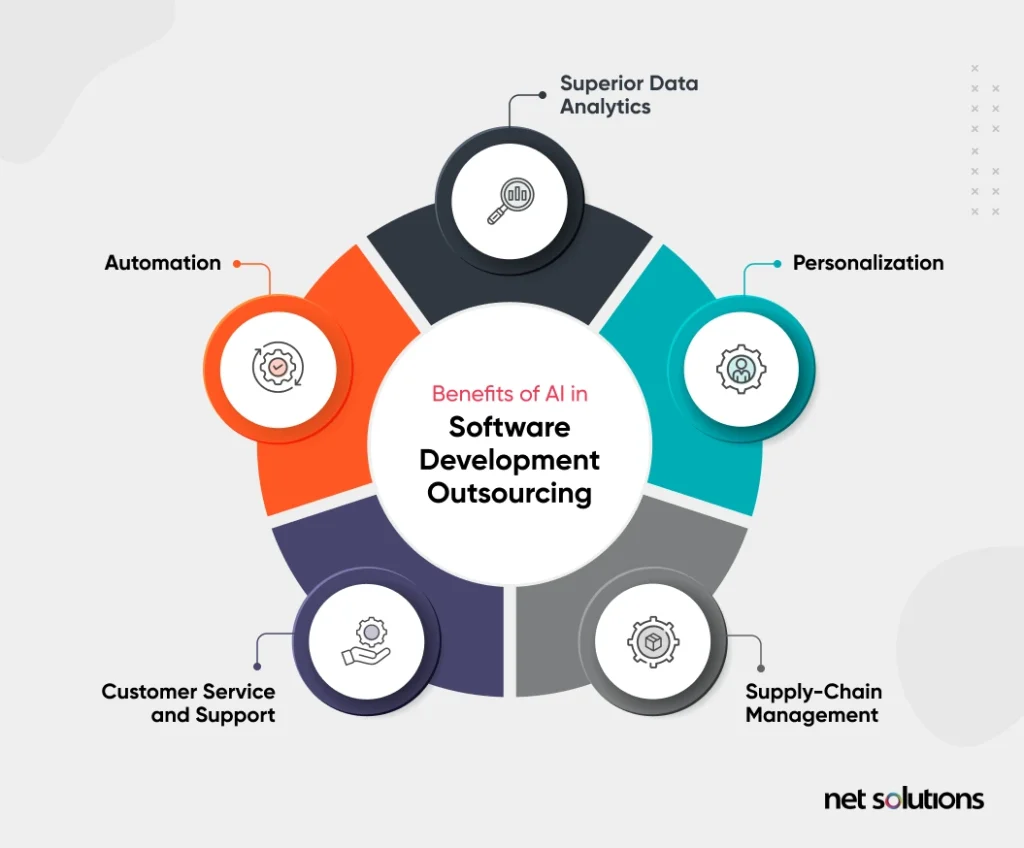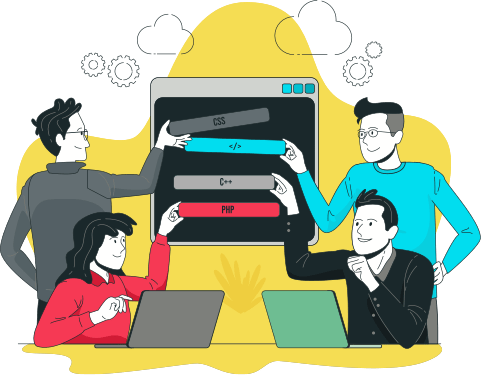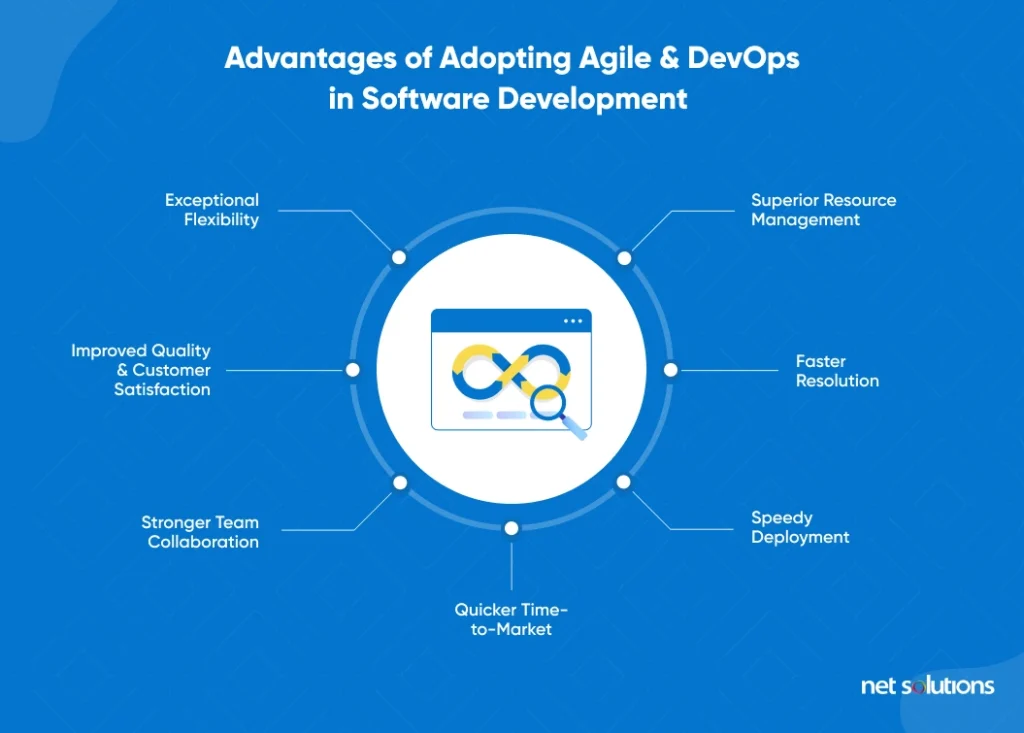IT outsourcing is an ever-evolving field, and leading outsourcing companies are always integrating new technologies and adapting to a changing landscape.
In recent years, we’ve seen an increased demand for greater efficiency, top-notch security, and cloud-computing capabilities when it comes to custom software development. We’ve also seen tremendous growth in digital transformation projects and app modernization.
In this guide, we’ll explore six of the latest outsourcing trends that the best software development companies are putting to use. These are must-haves when searching for an outsourcing partner.
6 Software Development Outsourcing Trends
We sometimes think of trends as passing fads, like man buns and avocado toast. Here at Net Solutions, however, we’re interested in those tech trends that are changing the software development industry for the better—and those that will shape the outsourcing market in the coming years.
With this in mind, we’ve curated a list of six of the most exciting, world-changing concepts and technologies impacting the outsourcing industry right now. Many of these topics are all over the news (like AI and data privacy) while others are talked about more within the tech sector (like app modernization and cloud-native development).
The final item on the list, Agile and DevOps, might surprise you since these methodologies have been popular for more than a decade (and Agile has been around for more than 20 years). However, we included them because they’ve continued to grow in popularity, and because forward-thinking developers are regularly refining them.
Trend #1: Artificial Intelligence (AI) and Intelligent Process Automation
Artificial Intelligence (AI) and Machine Learning (ML) are going to have a deep impact on countless industries, and learning to work with AI will help companies become more efficient and more competitive in a variety of ways.
Outsourcing providers who understand AI and offer AI-related services can help you stay ahead of the competition in a number of ways.
First, any software development team that uses AI to support their development efforts will likely be more efficient and get your products to market faster. AI’s efficiency can also help reduce software development outsourcing costs.
Second, beyond the role of AI in software development, you’ll want to take full advantage of AI in your own business wherever possible. A software development firm that offers AI consulting and development as part of its outsourcing services brings its clients the following benefits.

- Superior data analytics: Companies are using AI to gather and process large volumes of data to better understand their customers and market trends.
- Personalization: AI allows eCommerce brands and other companies to send personalized ads and offers to customers and prospects.
- Supply-chain management: Legacy retailers like Walmart have revolutionized supply-chain management with AI and Internet of Things (IoT) technology, creating more efficient, accurate, and cost-effective systems to manage inventory and shipment.
- Customer service and support: AI Chatbots are helping customers find answers to questions that would have once required human intervention.
- Automation: AI is helping companies automate mundane tasks, using technologies like Robotic Process Automation (RPA).
Of course, that really just scratches the surface. AI is a powerful way to improve the customer experience, create quality software, achieve massive cost savings, and boost your bottom line.
Trend #2: Data Analytics Services
Data science and big data have been front and center in the news for a number of years now, often as it relates to privacy concerns such as the Cambridge Analytica and Facebook controversy. So, what’s it doing on our list now?
The rise in digital transformation, app modernization, AI, and cloud-based computing has created the perfect environment for data analysis to thrive.
That’s because modern, cloud-based apps are no longer siloed, and they can process large volumes of data. Plus, AI technologies like sentiment analysis make it easy to spot trends in customer data and the market as a whole.
What follows are a few ways that data analytics services are helping businesses thrive.
- Better data means better decisions: Modern analytics allow companies to draw from very large sample sizes, which increases statistical significance and allows them to make informed decisions.
- Improved operational efficiency: Companies can look inward and analyze their own processes with strong data, allowing them to improve productivity and profits.
- Risk management: Access to larger, more comprehensive data sets allows companies to spot and address challenges with great accuracy.
These are just a few of the ways that software with strong analytics capabilities can help you succeed. That’s why it’s so important to work with software outsourcing companies that understand data analytics and integrate data science into their software solutions.
Trend #3: Cybersecurity and Data Privacy
Cybersecurity and data privacy are by no means new, so you may be wondering—why did they make our list of outsourcing trends?
According to the Harvard Business Review, cybersecurity threats are growing at a rapid pace. Not only is the sheer volume of threats expanding, but the number of ways bad actors can deceive your staff and penetrate your data is growing as well.
That’s the flip side of recent advancements in AI, along with the explosion in the number of interconnected devices. We can expect to see 41.6 billion IoT devices in use by 2025.
On top of that, devices we use every day contain code that bad actors can potentially hack. According to the Harvard Business Review article referenced above, the original space shuttle’s code base included just 400,000 lines of code, while today’s cars average 100 million lines of code.
Here are some of the growing threats on the horizon.
- AI-driven attacks: AI can increase the number of attempts to penetrate a given system. It can also better impersonate human beings and native speakers of whichever language it’s targeting.
- Supply-chain attacks: Today’s supply chains rely heavily on information technology, which means a cyberattack could potentially cripple an organization if it succeeds.
- Attacks on IoT devices: By their very nature, IoT devices are tied to the cloud. This opens the doors to amazing advancements, but it also leaves companies vulnerable to bad actors.
- Deepfakes: Today’s AI, combined with other burgeoning technologies, can create convincing videos and photos of real human beings, even imitating a specific person’s voice. Cybercriminals can use this to their advantage to extort money from naive victims.
Cybersecurity, data security, and data protection are more important now than ever, so it’s important to integrate the latest technologies into your product development efforts.
Trend #4: Cloud-Native Development
Cloud-native apps are designed to work in a cloud environment, using microservices and containerized, headless architecture for its flexibility and scalability. In fact, cloud computing makes it that much easier to take advantage of all the trends we’ve mentioned so far: AI, enhanced security, and better data collection and processing.
In addition to these benefits, cloud-native development offers:
- Flexibility: Cloud-native apps, with their composable architecture, make it much easier to add functionality to an app. Plus, you can completely repurpose the frontend or backend of an app for other purposes.
- Greater reliability: Since they’re designed to work in the cloud, cloud-native apps tend to be much more dependable than legacy applications.
- Faster deployment: Cloud environments are far more agile, allowing for Continuous Delivery and Continuous Integration (CD/CI) that accelerates the development process.
- Cost savings: The pay-as-you-go model of cloud-based infrastructures like AWS means that an application can scale up or scale down depending on traffic and demand. This tends to be a more cost-effective model compared to legacy requirements.
Cloud computing really is the way of the future. When selecting an offshore, nearshore, or onshore partner, be sure to find one with plenty of experience developing cloud-native apps.
Trend #5: App Modernization
App modernization is at the core of digital transformation, and updating legacy apps and infrastructures makes it possible to access technology that will give you a competitive edge. Of course, app modernization isn’t something that large enterprises can perform overnight. It takes careful planning and prioritizing.
While you may end up completely rebuilding or refactoring your most important apps right away, you might retain others. And of course, those are just some of your options.
To guide enterprises in their app modernization efforts, Gartner created the 7R model of app modernization, with each “R” representing a different way to modernize a given app. Here is a brief summary of the 7Rs.
- Rehosting: Also known as a lift-and-shift, rehosting involves moving data and applications to the cloud without making fundamental changes to the underlying architecture.
- Refactoring: Refactoring or rearchitecting means completely rewriting the underlying code.
- Replatforming: Sometimes called a lift-and-reshape, replatforming involves low-touch upgrades.
- Rebuilding: As the name implies, rebuilding means creating an entirely new application from scratch.
- Replacing: Sometimes called drop-and-shop, this involves eliminating the old application and purchasing an entirely new one to serve similar business processes.
- Retaining: Retaining a legacy application involves holding onto it without migrating it to the cloud. Instead, you can build an API layer around it, which allows it to interact with your modern app ecosystem.
- Retiring: Retiring an app simply means taking it out of your ecosystem if it’s no longer needed.
App modernization is key to digital optimization, but it’s absolutely vital to do it right. Otherwise, you may face security issues, data loss, or downtime.
Many in-house teams don’t have experience with app modernization, so companies often rely on outsourcing partners and external software development services to guide their efforts.
Looking for an experienced app modernization partner?

Trend #6: Agile and DevOps Adoption
Why did we include Agile and DevOps adoption on a list of current trends?
As we mentioned above, both Agile and DevOps are on the rise, with a recent study showing that the adoption of Agile has gone from 37% to 86% in recent years. Meanwhile, the market for DevOps-related products is poised to grow at a 19.7%
CAGR, from 10.5 billion in 2023 to 25.5 billion in 2028.
The advantages of adopting Agile include:

- Exceptional flexibility:Agile is designed for flexibility, with short sprints and regular reviews that allow teams to continuously adapt and refine requirements based on feedback.
- Improved quality and customer satisfaction: As an iterative process, Agile gives birth to software that addresses customer requirements and market demand.
- Stronger team collaboration: Agile is designed to encourage regular communication between team members, which is essential because software design and development is a highly collaborative process.
- Quicker time-to-market:The systematic approach that Agile takes improves time-to-market, giving companies a competitive edge.
The advantages of adopting DevOps include:
- Quicker deployments:The DevOps focus on automation increases the frequency of deployments. Rapid, reliable deployments offer a powerful advantage.
- Faster issue resolution: The regular communication that DevOps developers engage in allows them to spot problems and address them earlier, saving money and improving efficiency.
- Superior resource management: DevOps reduces waste in the development process and optimizes the use of physical and human resources.
Each of these benefits has contributed to the rising popularity of both DevOps and Agile among both in-house and outsourced software development teams.
What is The Future of Software Development Outsourcing?
Outsourcing is expected to remain in high demand in the coming years, with some studies predicting a 9.4% annual growth rate due to a number of factors.
Companies that work with outsourcing partners experience the following benefits.
- Cost savings:Outsourcing to a qualified partner is far more cost-effective than hiring in-house employees alone.
- Talent shortage: Even when companies do hire in-house employees, the current shortage of software engineers makes it challenging to find top developers. Outsourcing is a good way to fill the talent gap.
- Increased efficiency: Getting releases to market faster can provide a significant competitive advantage.
Of course, most companies are not interested in hiring just any software development firm. The future of outsourcing belongs to those firms that work side-by-side with their clients, seeing themselves as strategic partners and helping their clients avoid common software development outsourcing challenges.
Rather than simply fulfilling orders, the outsourcing companies that will rise to the top in the years to come are those that take a strategic approach to design, development, and project management. They’ll also be those outsourcing firms that take advantage of all the latest technology, including AI, ML, and IoT.
Looking for an Experienced, Strategic Outsourcing Partner?
Net Solutions is a full-service software development firm that has been serving startups and large enterprises for over 20 years. Our clients include the Harvard Business Review, Xerox, Euro Car Parts, and American Golf, just to name a few.
We offer staff augmentation as well as full-scale, end-to-end software design and development services, including: User research, User Interface (UI) User Experience (UX) design, development, QA testing, and project management.
Contact us today to discuss your next project.
SHARE THIS POST
Table of Contents
Related Resources
- 10 Key Benefits of Outsourcing Software Development
- 10 Common Software Outsourcing Challenges [With Solutions]
- 19 Best Software Development Outsourcing Companies in 2025
- How Much Does It Cost to Outsource Software Development?
- Software Development Outsourcing: India's Top 11 Contenders
- Comparing Software Development Outsourcing Models: A Decision-Maker's Guide
- A Guide to Nearshore Software Development Outsourcing [2025]
- Outsourcing Software Development: Evaluating the Pros and Cons
- 15 Questions to Ask when Outsourcing Software Development
- Outsourcing Software Development for Startups [2025 Guide]
- 2025 Software Development Outsourcing Statistics: Trends, Insights & Predictions


